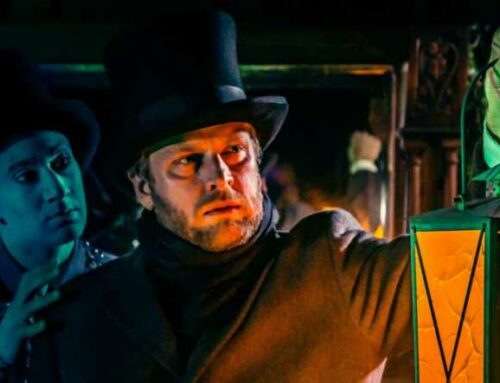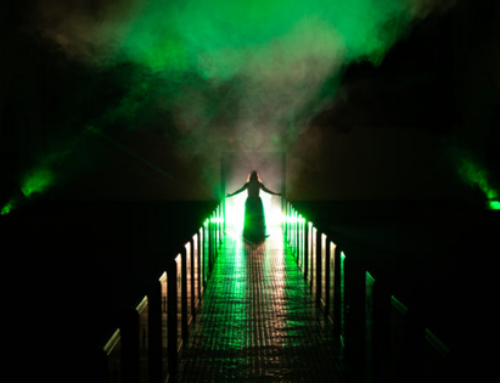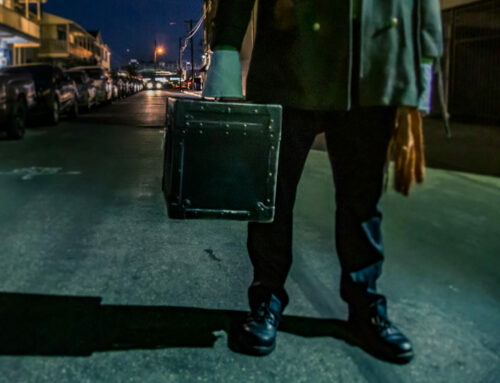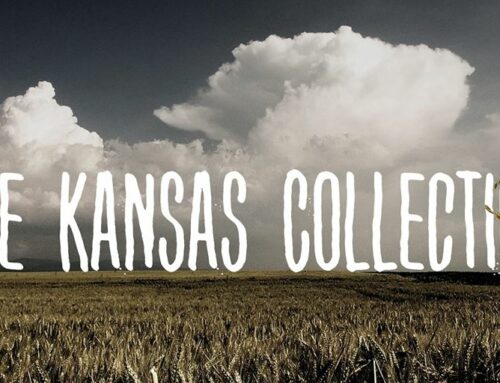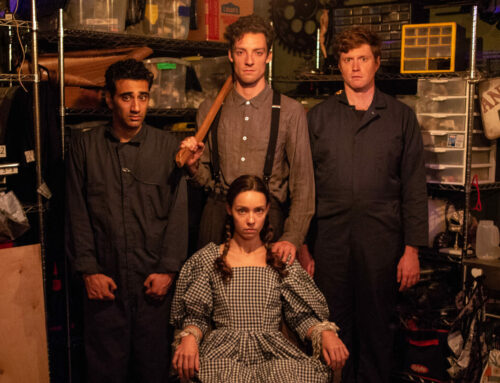As all great partnerships do, the story of The Speakeasy Society began in a bathroom. However, this wasn’t just any ordinary bathroom. This one, of course, was inhabited by three witches; witches who had a story to tell, double double, toil and trouble…
But, I am getting a bit ahead of myself, so we’ll come back to that.
If you live in the Southern California area, and enjoy the immersive scene, then chances are you have heard of, but more likely experienced, a show from The Speakeasy Society. From Ebenezer: An Immersive Christmas Carol to The Johnny Cycle to The Kansas Collection (including quite a few others), they have put on some truly fantastic productions that have left audience members wowed.
Since they are celebrating their fifth anniversary this year, I wanted to chat with the folks behind the scenes to learn a bit more about their story, and how they came to be. When I reached out to them, they very kindly invited me into their home to chat about their life and works.
On a gorgeously sunny Saturday morning, I arrived. Before I even had a chance to knock, Matthew Bamberg-Johnson (Artistic Director) opened it with a hearty greeting and invited me inside. As soon as I took my first step in, the smell of pumpkin bread filled the air as Genevieve Gearhart (Artistic Director) was just pulling it out of the oven (and let me tell you, between that and the homemade maple butter, it was delicious). Soon after, Chris Porter (Associate Artistic Director) arrived as well, and we four settled around the table to begin our chat.
The initial seed for The Speakeasy Society started when Gearhart meet Julianne Just (Artistic Director) in New York City.
“We met through a mutual friend who started their own theater company,” Gearhart said. “We were all directing and producing each other’s shows – and discovered we had shared artistic values and interests and eventually, Julianne and I went off to do our own shows.” Just soon was accepted into the MFA Directing program at CalArts, and came out to California. Soon after, Gearhart applied to graduate acting programs and decided to audition for CalArts.
It was crazy and weird, but it just felt right,” she said. It wasn’t long after that she was accepted and began her own CalArts experience. In her acting class is where she met Bamberg-Johnson.
“I did a lot of experimental stuff in undergrad, especially things surrounding the audience,” said Bamberg-Johnson. I studied performance theory and the history of interactive events- a lot of the the creators I studied came from the visual art world.” He credits CalArts with helping him expand as a performer.
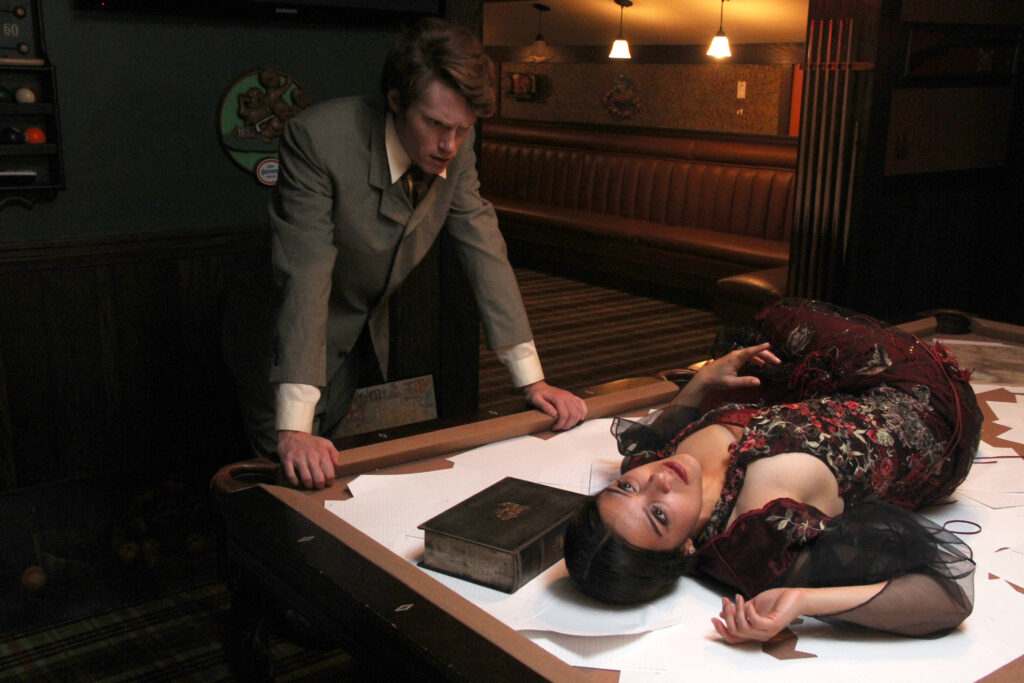
Photo by Fernando Belo from “The Hollow”
After their initial meeting, Gearhart and Bamberg-Johnson became “school married” (their words!) very quickly, especially when it came to the type of work they were making.
Just began teaching a directing class at CalArts, as was part of the curriculum, that Gearhart took because she thought it would be fun! Every week, they had to bring in a new piece, and one week, the assignment was to stage the first scene from Macbeth with the witches. Having just seen Sleep No More in New York and What Remains at the Edinburgh Fringe Festival, Gearhart brought an immersive flair to the scene. She staged it in a bathroom, and when Just saw it, she thought it was so good that it needed to be a longer show.
Together they created a 25-minute piece, which was still staged in the bathroom, with the toilet as their cauldron. Everyone involved loved doing it, and wanted to do more of the same…and so, Just and Gearhart decided to form their own theater company.
After taking an entrepreneurship class, where their teacher helped them shape the company and their roles, they wrote their mission statement (“Which has since been edited to be a lot shorter,” Gearhart joked).
After they graduated, they staged Kitchen/Sugar/Bullet/Blank, an immersive piece based on the play FeFu and Her Friends in their house, where 14 people came over for a full dinner and drinks with the characters. While it was a limited run, one of their performances was attended by Michael Jung, a VP of Creative Entertainment at Walt Disney Imagineering. While they were at CalArts, he acted as a mentor for Just and Gearhart, and after seeing this show, he decided to help out with seed money to fully form the company.
“He really got us started, and his support was instrumental in making us what we are today,” said Bamberg-Johnson.
Kitchen/Sugar/Bullet/Blank was also the show during which Porter became a fan.
Just met Porter in the admissions office at CalArts, he had recently graduated with a degree in music composition.
“I was standing in the shower stall, listening to a conversation between two women in the bathroom, and I loved how weird and voyeuristic it was,” he said. “I knew I wanted to be a part of it.”
Porter was asked to score The Speakeasy Society’s version of a Christmas Carol, which first premiered in 2013 at Chloe’s the secret bar at Golden Road Brewing.
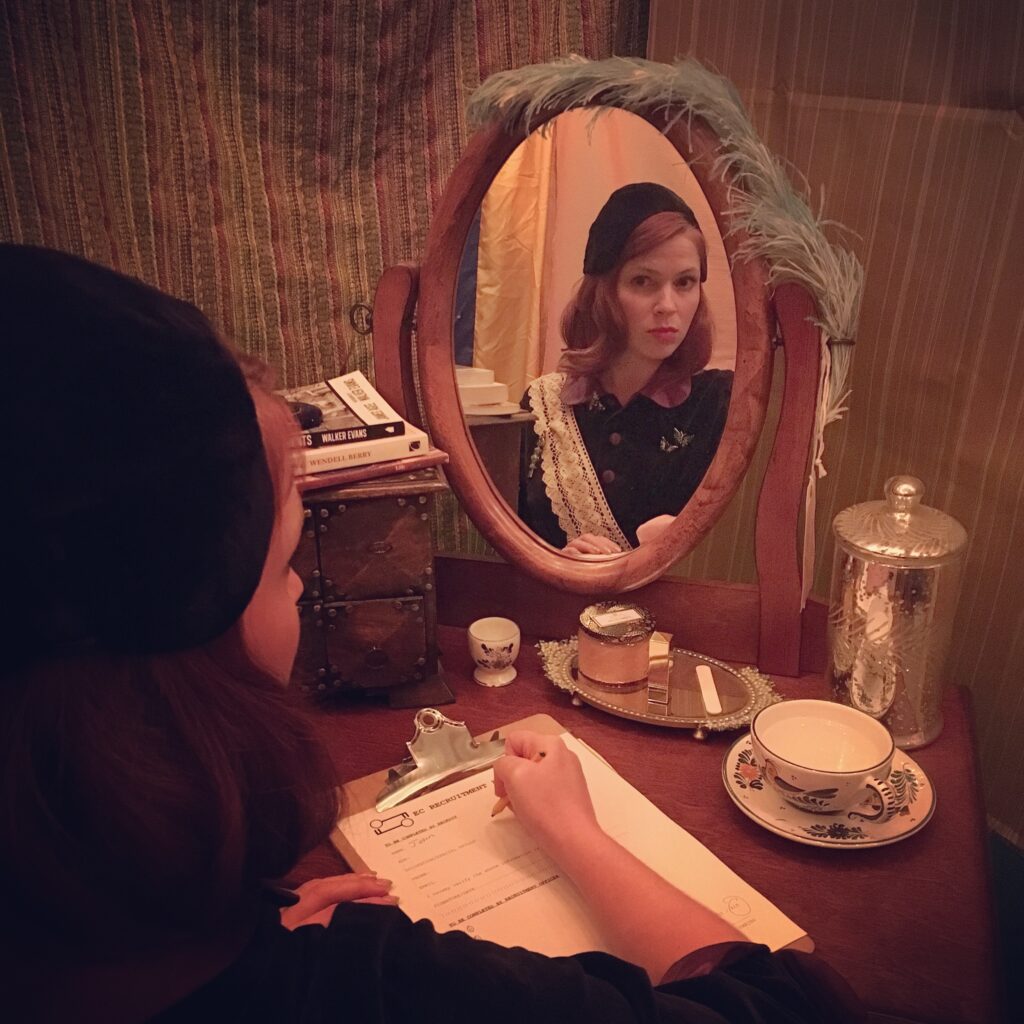
Photo by Chris Porter from “The Kansas Collection”
It was at this point during our meeting that Porter paused the conversation and apologized for seeming distracted, as he was hard at work on his laptop. He was in the midst of editing a video that was to go out that day to certain participants of The Kansas Collection, and wanted to get Gearhart’s opinion on something. After watching it for a few moments, she enthusiastically exclaimed “That’s great!”, and I was left to ponder just what they had up their sleeve for poor Dorothy…
But, getting back to the conversation, I learned that the very house I was currently in was where they workshop a lot of their shows overall.
“Just having a home, with things in it, it gives the actors stuff to work with, to play off of,” Gearhart explained. In fact, it was in the very same shower that Porter was in that scenes from The Johnny Cycle came about.
Bamberg-Johnson first read Johnny Got His Gun, by Dalton Trumbo, in high school. Written in 1938, the book is about Joe Bonham, who was caught in the blast of an artillery shell during World War I. Despite having lost his limbs, and his face, his mind still functions perfectly, leaving him a prisoner in his own body.
“It just never left my head,” he said. “It haunted me, and I re-read it again in college. At the same time, I was working on material related to the happenings of the 50’s and 60’s; forcing people to choose what to look at certain things in a room of too many choices, removing senses.” He thought it would be a challenge to tell a story as an immersive piece, but he really wanted to bring Johnny Got His Gun to life in a visceral form.
Just eventually read the first page of the book and thought it would make a great immersive experience
They originally envisioned it as a much bigger show, something they would do many years later. However, they were lucky to find the Pasadena American Legion, and once they toured their space, they knew it was a match.
While the space wasn’t large, they knew they could put the performance “on rails” so to speak, to guide people through it. As they workshopped the piece they realized the story itself was too big for this single show, and they would have to expand. And so, the three “cycles” of The Johnny Cycle were born.
They didn’t expect it to be a 3-show process at first, and they especially did not expect it to take 3 years to tell. However, they were determined that the story deserved to be told, and they wanted to tell it right. Though it took some time to get there, the story of became more and more timely as the years went on.
For every show, but this one in particular, the team relies on heavy research of the material. While the book skips over the war entirely, instead opting to show a pre-and-post war environment, when it came time for The Johnny Cycle Part 2: The Shell, they wanted to carefully, but accurately, portray the war. None of the production team were service members themselves, but they did have cast members who were who helped them out.
They also pulled from first-hand accounts of soldiers during World War I, including poems they wrote while in the trenches, and also garnered some inspiration from some Civil War accounts as well.
It was while planning Part 2 that the company was contacted by Trumbo’s daughter. The team assumed that based on the scale of their pieces and the relative youth of the immersive movement in LA, they were flying underneath the radar, but since Trumbo was introduced as a character in that chapter, his name kept popping up in articles, and so, they received an inquiring email from Trumbo’s daughter, Mitzi.
“I sent her a letter, explaining how much the book meant to me, and what we were doing with it. Our intentions were pure, and she understood that,” Bamberg-Johnson said. “We stood by the work, and invited her to come see the show.” While Mitzi was unable to attend, Trumbo’s granddaughter, Samantha, came out to see Part 3.
“This was the most significant performance by far for us,” Bamberg-Johnson said. “She said she felt she got to know her grandfather even better through the piece, that she felt we understood the spirit of his work.“
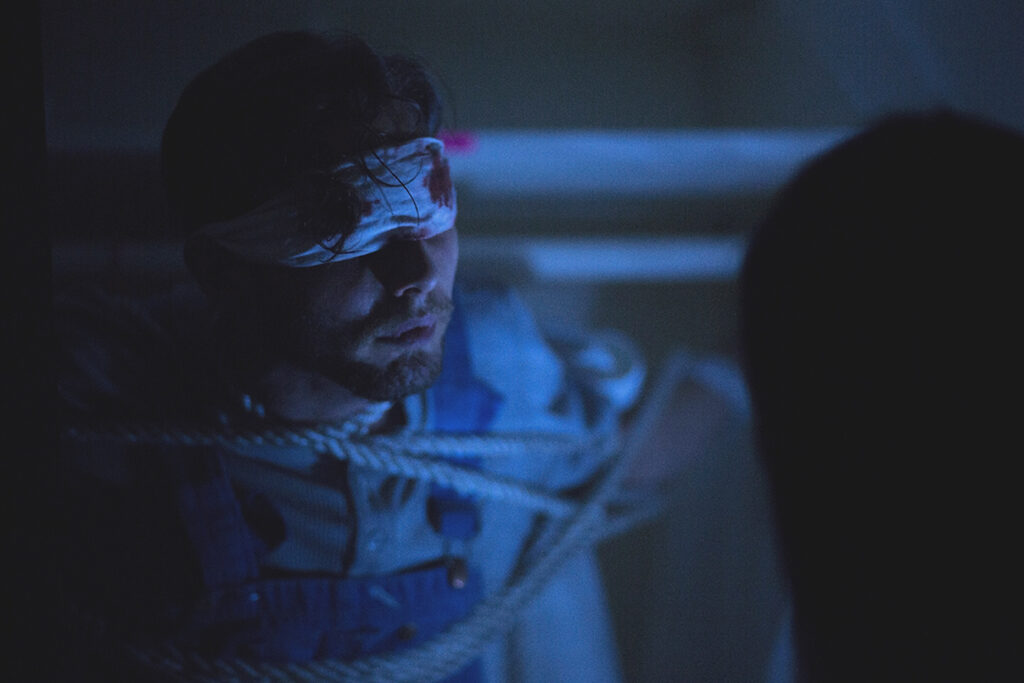
Photo by Daniel Kleen from “The Johnny Cycle: Part 2 – The Shell”
For those of you who have seen any of the shows, you know how incredibly emotional it was, and just how deeply it affected many of its audience members. While I only had a chance to catch The Johnny Cycle Part 3: The Living, it was an incredibly powerful piece, and one that left me in tears. I’d say it was definitely worth the wait.
“We spent so much of our lives doing that show, it was so rewarding to see how people reacted to it…to see that we didn’t waste our time doing it,” Bamberg-Johnson said.
When I asked them about how they all work together as a team, I wasn’t surprised at all to learn that each have their own very specific roles, and know what they are good at.
“We have to figure out every possible angle, we can’t allow things to not be thought out,” said Gearhart. Now, there are six members of the team, including John Henningsen (Producing Director) and newcomer but long time collaborator, Michael Bates.
“We wouldn’t be able to create a third of the content we do if it wasn’t for Porter’s writing or Henningsen’s business structure, and so on,” said Bamberg-Johnson.
They all go in different directions to make a show work, and when they come together in the end, it comes together nicely. They also have a system where some of them work on one project while others work on another, dividing up the tasks to make sure it all gets done.
The soul of the company lays in their collaboration- again, Gearhart stressed the importance of their workshops.
“It gives the actors the freedom to explore and take ownership over their character,” she explained. For example, for The Johnny Cycle Part 2: The Shell, they cast the ensemble, and wrote characters around the personalities of the actors. That process doesn’t work for all of their shows, but it is definitely helpful.
For their upcoming show, Wild Party, they created a character list and let their actors choose from it during the audition process.
Speaking of Wild Party, it’s part of The Broad Stage’s 2018 season. The show, set in 1926, has Zelda Fitzgerald hosting the must-attend event of the season to celebrate her husband’s new book.
This show came about when someone from The Broad Stage’s creative team approached the company because they had seen immersive work elsewhere, and thought it might be a good way to expand their audience to a younger clientele.
They pitched a concept that they had been considering for a while, a loosely adapted version of the poem The Wild Party, and wanted to focus on diverse casting for this show.
“Does F. Scott Fitzgerald have to be Caucasian? Of course not. We live and make work in a diverse community, and our casting should reflect that..”
The show has a combination of artists and historical figures from the 1920s, and is set just before the stock market crashed, but after sound came to film.
“I love the old tropes of Hollywood, like the young starlet disgraced by scandal, or Vaudeville actors trying to find work in the talkies. Hollywood is still trying to figure out what it is in this show,” said Gearhart.
While the still secret space is not traditional theatrical venue, it worked out well for what they wanted. Only 100 guests are admitted for each show, and there will be plenty of food and drinks to go around. The show is 90 minutes long, with plenty of intimate moments, alongside larger group experiences.
Speaking of, tickets for Wild Party are available now at this link.
As for their most recent, on-going work, The Kansas Collection has definitely taken Southern California by storm…no pun intended. It began when Noah Nelson at No Proscenium wanted them to do a piece at IndieCade, something with a big throughput and some kind of “gaming” aspect.
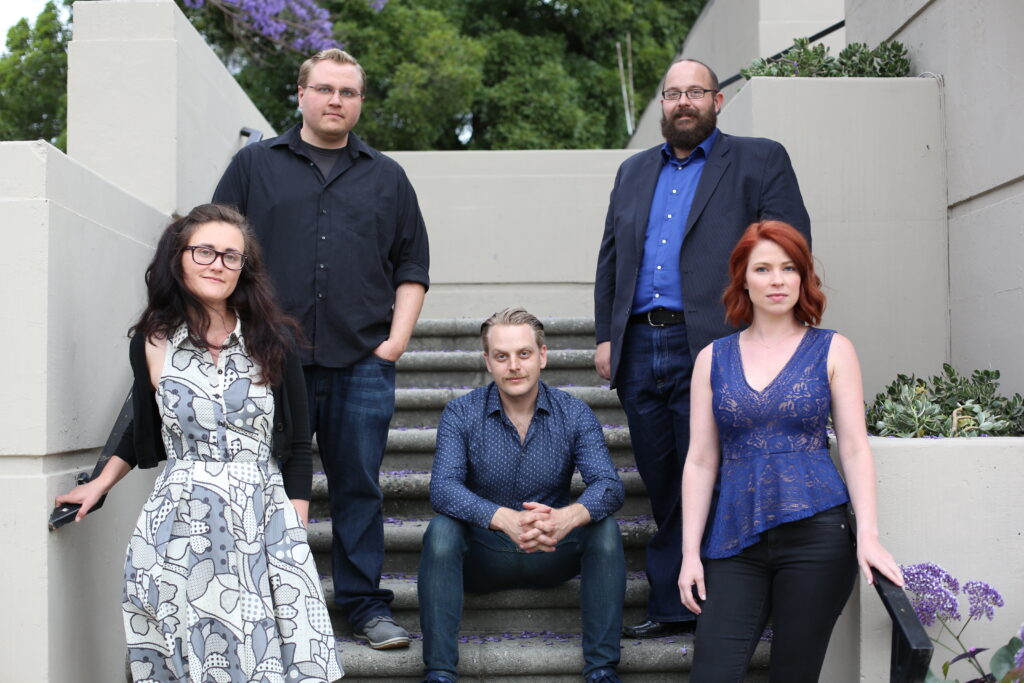
The Speakeasy Society – Photo by Chelsea Curtis
“What was interesting was that we almost pulled a fast one on audiences,” said Porter. “No one knew what it was, just that it was in the Dustbowl in Kansas. We didn’t actually say the word ‘Oz’ until the very end when people were swearing allegiances. Seeing people’s faces was great then they realized ‘Oh, shit! This is Oz!’”
They set up at USC in an hour and jumped right in. They were over capacity soon after, and had to crank out 75-80 people that night. They even went beyond their allotted time, and USC cut their power, forcing them to leave.
“We weren’t even sure if people would like it,” said Gearhart. “We didn’t plan beyond that night…it wasn’t even chapters at that point.” But once word got out, and people talked about how much fun it was, they knew they had to do more.
Because it was birthed as a project for a gaming festival, they referred to some of the mechanics from their favorite games. They looked to moments from the Fallout series and Bioshock: Infinite to find out what could work for them. Though when they started, they weren’t sure where they were going, now they have a much more defined purpose. The plot points for the remaining chapters are all mapped out.
As much as they try to anticipate how audience members will respond, they freely admit that sometimes they are totally wrong. They have had to write the next chapters in direct response to audience reactions. For example, for those playing along so far, you know that there are a few factions at play. However, the company realized they had a fan base that wanted to be a sort of support group for Dorothy…but they hadn’t planned on that. They adjusted Chapter 4: The Invitation to reflect that.
“What’s tricky about these shows is that we are giving the audience choices, but we still need to hit the plot points for everyone,” said Bamberg-Johnson. “There are aspects you can control, and others you can’t.”
They also have spread sheets for every audience member, tracking their progress and their actions. However, the amount of data capture they have to do for the show is mindboggling.
“It’s especially challenging when they give us a fake email address or I can’t read their handwriting,” Bamberg-Johnson laughed. “I have spent hours of detective work tracking down emails!”
“We’re a pretty analogue company, we don’t have a lot of technology tools to help us out. But I wish we had RFID tracking for this one,” joked Porter. But Porter also took on an extra role with The Kansas Collection, in which he directly responded to audience members, even when the show wasn’t running.
“There are characters you can text or call here,” he explained. “There is no bot, no system in place for responses. It’s all a real live person, and I sometimes spend hours responding. The enthusiasm is great!”
One of the biggest aspects of their mission is that taking care of audience members is very important to them. They always try to make sure everyone has a fulfilling experience.
“It’s a matter of figuring out the jigsaw pieces of making it all work,” said Gearhart. “As a performer, from the inside of the piece, we have to juggle all those considerations. Half of our brain is dedicated to the logistical demands: timing, performance on point, and so on. And then to figure out who has seen shows before, to make sure they get something different.”
“Sometimes that involves sneaky photos of audience members to tell our actors to do or not do things,” Bamberg-Johnson laughed.
“We try to have a positive experience for every audience member,” said Gearhart. “Especially when it to comes to people who have seen our shows over and over again.”
That was the genesis of giving tokens to audience members, so they can sometimes see extra bits of story when they return to a show created by The Speakeasy Society.
But at the end of the day, they love the community, and love how their work is appreciated.
A big thank you to Genevieve Gearhart, Matthew Bamberg-Johnson, and Chris Porter for taking the time to chat with me. Be sure to wish The Speakeasy Society a very happy fifth anniversary. I know I am not alone in looking forward to their next five years of work.
For more information on the Speakeasy Society, you can find them online at: http://speakeasysociety.com

